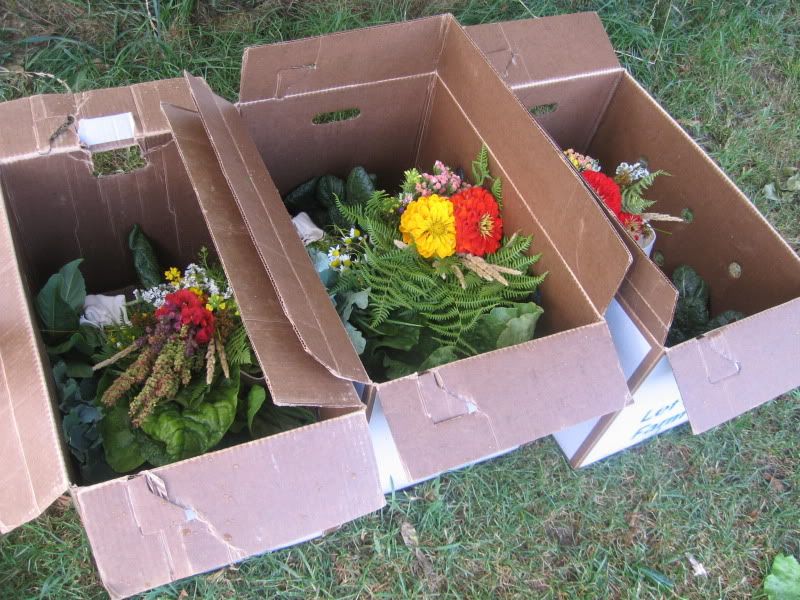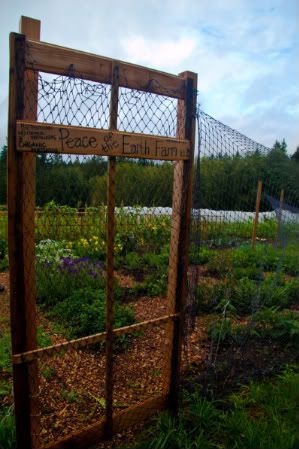What is Community Supported Agriculture?
Community Supported Agriculture (CSA) is a partnership between community members and farmers in which community members share in the benefits and risks of the growing season. In this partnership, customer's prepay for a share of production, usually provided in weekly installments for a set amount of weeks. These shares provide an early season source of income for the farm, allowing the farmer to purchase supplies and get the growing season started on a firm foundation. In return, the farmer distributes the bounty of food and flowers that follows later in the growing season to all the CSA members. As a result, CSA programs typically amount to much more than a simple exchange of money and goods, a community is built. A CSA is a wonderful way to support your local farmers as well as supply your family with the freshest and most healthy food available.
We have 4 CSA programs to choose from:
Summer Vegetable CSA- 12 installments, delivered weekly, $360 ($30/per installment), Mid June to Mid September
With enough vegetables to feed 2 to 4 adults, this CSA is a wonderful way to get more vegetables for your buck! Each week you will receive a box of vegetables as well as a small bouquet of flowers. Each week will vary in content as more vegetables come to delicious fruition.
Start (transplant) CSA- 6 installments of starts, delivered about every two weeks, mid May through early August, $150 ($25/per installment)
From arugula to zinnias, we'll provide all the starts you'll need for a wonderful summer and fall garden. Each installment, which will contain a mixture of vegetables, herbs, and flowers, will be timed to promote the best success of a particular plant. We'll take you from the first plantings of the spring right on through the summer for a successful fall and winter garden.
Flower CSA- 12 installments, delivered weekly, $120 ($10/per installment), mid June through mid September
We all need some color in our lives. Enjoy a lovely medium sized arrangement of flowers brought right to your door each week. Include this CSA with the Start CSA and receive $20 off!
Farm Dollar CSA- You Choose the Amount
Farm dollars are designed for those who like the idea of the CSA but enjoy more choices. Here's how it works: buy the farm dollars in May and exchange for farm goodness later in the growing season. Exchange at our farm stand or simply arrange for a delivery by email or phone. Choose from any available starts, vegetables or flowers!
We are now taking applications for next year's CSA programs. Since we only have a limited amount of spots we will need to have our customers fill out an initial application. Please email us at peaceoftheearthfarm@gmail.com and we'll send you an application. If we have space and we can accomodate you we will send you a CSA agreement and your spot will be reserved for next year's farm goodness.
Thursday, November 12, 2009
Wednesday, October 28, 2009
Garlic Love
It's time to plant Garlic here in the Pacific Northwest. No matter what your abilities are as a gardener, everyone can plant successful garlic!
Garlic 101
There are 2 main types of garlic, hard neck and soft neck. Soft neck varieties are the kind most commonly found in grocery stores because their shelf life is significantly longer than hard neck varieties. In fact, if dried and stored properly, soft necks can last all winter and spring long. Hard neck varieties tend to have a stronger flavor than soft necks but are best fresh or consumed within a few months of harvest. Hard necks generally produce one row of large cloves around a center stem (fig 1). This stem will produce an edible flower called a scape in the late spring (fig 2). This scape should be pulled out when it starts to curve all the way around. Pulling the scape prevents the garlic from going to seed. If this scape is not pulled out, then the clove will not develop into a full bulb of garlic and it will put all its energy into making it's flower and subsequent seeds. These scapes are a real treat and can be eaten raw like chives, cooked in a stir fry, or my personal favorite, all grilled up on the barbecue. They have a that wonderful garlic flavor and are a bit spicy! Soft neck varieties typically have several rows of cloves (fig 3). The cloves on the outside are about medium sized and get smaller and smaller towards the center. Soft neck varieties (in all but a few cases) do not have a scape and therefore have a less rigid neck. This makes them the ideal varieties for one of my favorite late summer activities: garlic braiding. Garlic braids make excellent holiday gifts because they are both edible and beautiful. You'll be able to purchase garlic braids next summer and fall here at the farm. I like to weave in dried flowers and even cayenne peppers for some extra color and flavor.
Fig 1: the Inside of Hardneck Garlic:
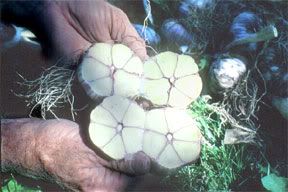
Fig. 2: Garlic Scape

Fig 3: The Inside of Soft Neck Garlic

Garlic Planting:
In the fall, usually late October or even November is the right time to plant garlic in the Pacific Northwest. If you plant a clove of garlic in the fall, by summer you will have a whole bulb of garlic. Plant cloves about 4 to 6 inches apart about 1 to 4 inches deep. Cover with a mulch such as straw to help insulate and protect garlic as it rests during the winter. Planting in a fall is important because garlic needs the cold winter months for proper growth. However in very cold climates make sure you plant 4 to 6 weeks before the ground has a hard freeze to help establish a root system. When you buy seed garlic it usually comes in a bulb. Crack open bulbs and separate cloves very carefully. Try not to bruise or scrape the tissue of the clove because this will increase the chance of the clove getting infected with a fungus or other unwanted disease. You do not need to fully peel the garlic clove, just separate them from one another. Bulbs should be broken only a day or two before planting. There is a direct correlation between the size of the clove and the size of the bulb. Small cloves make smaller bulbs, bigger cloves makes bigger bulbs. Therefore most gardeners and farmers only plant the largest cloves and save the rest for cooking or give them to kids or neighbors to plant. Also pay special attention to the orientation of the clove. Make sure you put the basil end down, this is where the roots will grow from (fig 4). One last note, garlic is very susceptible to disease and should never be planted in the same place two years in a row. Rotate the place where you grow garlic and pay special attention to the bulbs you buy for seed. Be wary of planting grocery store garlic or garlic from neighbors or even local farmers. Once you get white rot, which is a common garlic fungus, it's in the soil pretty much for good. Also remember that, good fresh healthy garlic is always very hard. If your seed garlic is soft in any spot don't plant it. In fact, it's probably a good idea to dispose of the clove and even the whole bulb and then wash your hands before touching the rest of the garlic.
Fig 4: This is the orientation that the clove should be in for planting
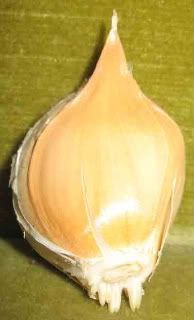
Spring Maintenance:
Garlic should be sown in well drained moist soil and mulched with straw or another mulch to help retain soil moister. Water if necessary in May and June however cut off water in June to help aid in the drying out process. Fertilize the garlic in February and then again in April but not again. Fertilizing after this point will cause plant to put out more green above ground growth and we want the plant to focus on its bulb. I recommend using an organic liquid fertilizer like fish emulsion or worm casting compost tea with some kelp meal. Sorry but I can never recommend chemical fertilizers for anything because I believe they are not healthy for humans, plants, animals or the earth! Pull back the straw mulch a couple times in the spring to weed and then put back mulch. Remember to pull those scapes from the hard neck varieties when they are all curled around. Harvest garlic when there are 2 to 3 mature scales surrounding the bulb, probably June or July. The above ground leafy growth can also be eaten like a you would a leek. To dry, bunch up 6 to 10 bulbs by their leaves and hang in cool dry place away from direct sun light. Once the garlic is dried (in a bout 2 to 4 weeks). Store at 50 degrees with humidity at 50% to 65%. This will help keep the garlic fresh and keep it form sprouting.
Finding Seed Garlic
Right now you can get some lovely soft neck garlic from my favorite seed company "Uprising Seeds". This is a local Washington company that grows and sells organic seeds. They are located in Bellingham, Washington and grow almost all of their own seed, the remaining bit of seed they distribute was grown by other Washington farmers. They have an emphasis on heirloom varieties are 100% organic and they just plain rock in terms of service and their love of the earth, this is a great company to support. Find them at http://uprisingorganics.com/
Some other good sources for seed garlic are High Mowing Seeds, Peaceful Valley Farm Supply, Territorial Seeds, and Fillery.
Good luck... now... go plant that Garlic!!
Garlic 101
There are 2 main types of garlic, hard neck and soft neck. Soft neck varieties are the kind most commonly found in grocery stores because their shelf life is significantly longer than hard neck varieties. In fact, if dried and stored properly, soft necks can last all winter and spring long. Hard neck varieties tend to have a stronger flavor than soft necks but are best fresh or consumed within a few months of harvest. Hard necks generally produce one row of large cloves around a center stem (fig 1). This stem will produce an edible flower called a scape in the late spring (fig 2). This scape should be pulled out when it starts to curve all the way around. Pulling the scape prevents the garlic from going to seed. If this scape is not pulled out, then the clove will not develop into a full bulb of garlic and it will put all its energy into making it's flower and subsequent seeds. These scapes are a real treat and can be eaten raw like chives, cooked in a stir fry, or my personal favorite, all grilled up on the barbecue. They have a that wonderful garlic flavor and are a bit spicy! Soft neck varieties typically have several rows of cloves (fig 3). The cloves on the outside are about medium sized and get smaller and smaller towards the center. Soft neck varieties (in all but a few cases) do not have a scape and therefore have a less rigid neck. This makes them the ideal varieties for one of my favorite late summer activities: garlic braiding. Garlic braids make excellent holiday gifts because they are both edible and beautiful. You'll be able to purchase garlic braids next summer and fall here at the farm. I like to weave in dried flowers and even cayenne peppers for some extra color and flavor.
Fig 1: the Inside of Hardneck Garlic:

Fig. 2: Garlic Scape

Fig 3: The Inside of Soft Neck Garlic

Garlic Planting:
In the fall, usually late October or even November is the right time to plant garlic in the Pacific Northwest. If you plant a clove of garlic in the fall, by summer you will have a whole bulb of garlic. Plant cloves about 4 to 6 inches apart about 1 to 4 inches deep. Cover with a mulch such as straw to help insulate and protect garlic as it rests during the winter. Planting in a fall is important because garlic needs the cold winter months for proper growth. However in very cold climates make sure you plant 4 to 6 weeks before the ground has a hard freeze to help establish a root system. When you buy seed garlic it usually comes in a bulb. Crack open bulbs and separate cloves very carefully. Try not to bruise or scrape the tissue of the clove because this will increase the chance of the clove getting infected with a fungus or other unwanted disease. You do not need to fully peel the garlic clove, just separate them from one another. Bulbs should be broken only a day or two before planting. There is a direct correlation between the size of the clove and the size of the bulb. Small cloves make smaller bulbs, bigger cloves makes bigger bulbs. Therefore most gardeners and farmers only plant the largest cloves and save the rest for cooking or give them to kids or neighbors to plant. Also pay special attention to the orientation of the clove. Make sure you put the basil end down, this is where the roots will grow from (fig 4). One last note, garlic is very susceptible to disease and should never be planted in the same place two years in a row. Rotate the place where you grow garlic and pay special attention to the bulbs you buy for seed. Be wary of planting grocery store garlic or garlic from neighbors or even local farmers. Once you get white rot, which is a common garlic fungus, it's in the soil pretty much for good. Also remember that, good fresh healthy garlic is always very hard. If your seed garlic is soft in any spot don't plant it. In fact, it's probably a good idea to dispose of the clove and even the whole bulb and then wash your hands before touching the rest of the garlic.
Fig 4: This is the orientation that the clove should be in for planting

Spring Maintenance:
Garlic should be sown in well drained moist soil and mulched with straw or another mulch to help retain soil moister. Water if necessary in May and June however cut off water in June to help aid in the drying out process. Fertilize the garlic in February and then again in April but not again. Fertilizing after this point will cause plant to put out more green above ground growth and we want the plant to focus on its bulb. I recommend using an organic liquid fertilizer like fish emulsion or worm casting compost tea with some kelp meal. Sorry but I can never recommend chemical fertilizers for anything because I believe they are not healthy for humans, plants, animals or the earth! Pull back the straw mulch a couple times in the spring to weed and then put back mulch. Remember to pull those scapes from the hard neck varieties when they are all curled around. Harvest garlic when there are 2 to 3 mature scales surrounding the bulb, probably June or July. The above ground leafy growth can also be eaten like a you would a leek. To dry, bunch up 6 to 10 bulbs by their leaves and hang in cool dry place away from direct sun light. Once the garlic is dried (in a bout 2 to 4 weeks). Store at 50 degrees with humidity at 50% to 65%. This will help keep the garlic fresh and keep it form sprouting.
Finding Seed Garlic
Right now you can get some lovely soft neck garlic from my favorite seed company "Uprising Seeds". This is a local Washington company that grows and sells organic seeds. They are located in Bellingham, Washington and grow almost all of their own seed, the remaining bit of seed they distribute was grown by other Washington farmers. They have an emphasis on heirloom varieties are 100% organic and they just plain rock in terms of service and their love of the earth, this is a great company to support. Find them at http://uprisingorganics.com/
Some other good sources for seed garlic are High Mowing Seeds, Peaceful Valley Farm Supply, Territorial Seeds, and Fillery.
Good luck... now... go plant that Garlic!!
Tuesday, October 13, 2009
Fall Greetings!
Howdy Everyone! Wow what a great farm season we have had. We are now turning our attention to next year and beyond. With that in mind, we have been planning for next year's cultivation and in particular cover crop and compost. Fall is a great time to compost and anyone can do it. The most simple compost pile is just a pile of dry leaves with some weeds or food scraps. However, you can also layer the pile in such a way as to encourage more rapid decomposition and the proper nutrient levels. Adding manure or worms can be helpful for added fertility as well. Turn your pile often, up to once or twice a week to be sure it's getting enough air and check that the pile is neither too wet or too dry. Feel free to email us with specific composting questions. And hey, check out my farmy friend, Kellie stand next to one of our recent piles:
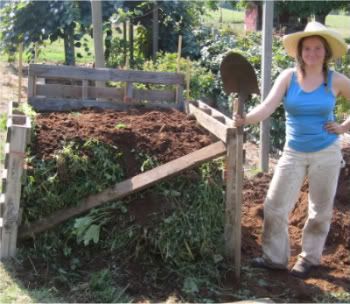
We decided to sow a vetch and rye mix to our acre for next year's production. The rye will help suppress weeds and add to the organic material in the soil and the vetch with add valuable nitrogen to the soil. Just take a look at this beautiful organic cover crop seed:
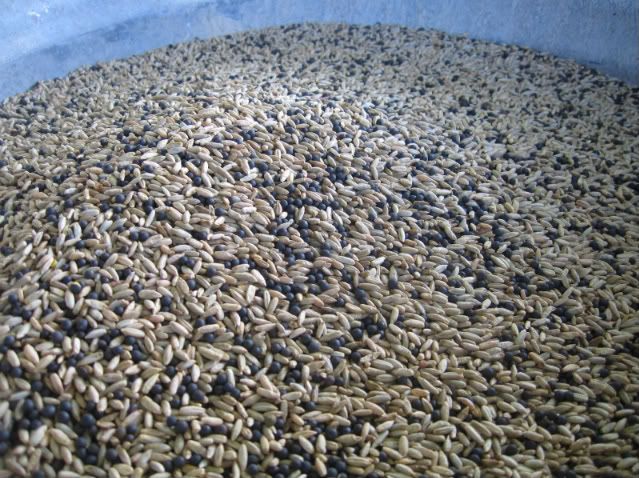

We decided to sow a vetch and rye mix to our acre for next year's production. The rye will help suppress weeds and add to the organic material in the soil and the vetch with add valuable nitrogen to the soil. Just take a look at this beautiful organic cover crop seed:

Thursday, September 17, 2009
Sign Up Now for Next Year's CSA Programs!
We are now taking applications for next year's CSA programs. Since we only have a limited amount of spots we will need to have our customers fill out an initial application. Please email us at peaceoftheearthfarm@gmail.com and we'll send you an application. If we have space and we can accomodate you we will send you a CSA agreement and your spot will be reserved for next year's farm goodness.
We have decided to offer serveal different options for next year's CSA. Now we have 4 CSA programs to choose from:
Summer Vegetable CSA- 12 installments, delivered weekly, $360 ($30/per installment), Mid June to Mid September
With enough vegetables to feed 2 to 4 adults, this CSA is a wonderful way to get more vegetables for your buck! Each week you will receive a box of vegetables as well as a small bouquet of flowers. Each week will vary in content as more vegetables come to delicious fruition.
Start (transplant) CSA- 6 installments of starts, delivered about every two weeks, mid May through early August, $150 ($25/per installment)
From arugula to zinnias, we'll provide all the starts you'll need for a wonderful summer and fall garden. Each installment, which will contain a mixture of vegetables, herbs, and flowers, will be timed to promote the best success of a particular plant. We'll take you from the first plantings of the spring right on through the summer for a successful fall and winter garden.
Flower CSA- 12 installments, delivered weekly, $120 ($10/per installment), mid June through mid September
We all need some color in our lives. Enjoy a lovely medium sized arrangement of flowers brought right to your door each week. Include this CSA with the Start CSA and receive $20 off!
Farm Dollar CSA- You Choose the Amount
Farm dollars are designed for those who like the idea of the CSA but enjoy more choices. Here's how it works: buy the farm dollars in May and exchange for farm goodness later in the growing season. Exchange at our farm stand or simply arrange for a delivery by email or phone. Choose from any available starts, vegetables or flowers!
We have decided to offer serveal different options for next year's CSA. Now we have 4 CSA programs to choose from:
Summer Vegetable CSA- 12 installments, delivered weekly, $360 ($30/per installment), Mid June to Mid September
With enough vegetables to feed 2 to 4 adults, this CSA is a wonderful way to get more vegetables for your buck! Each week you will receive a box of vegetables as well as a small bouquet of flowers. Each week will vary in content as more vegetables come to delicious fruition.
Start (transplant) CSA- 6 installments of starts, delivered about every two weeks, mid May through early August, $150 ($25/per installment)
From arugula to zinnias, we'll provide all the starts you'll need for a wonderful summer and fall garden. Each installment, which will contain a mixture of vegetables, herbs, and flowers, will be timed to promote the best success of a particular plant. We'll take you from the first plantings of the spring right on through the summer for a successful fall and winter garden.
Flower CSA- 12 installments, delivered weekly, $120 ($10/per installment), mid June through mid September
We all need some color in our lives. Enjoy a lovely medium sized arrangement of flowers brought right to your door each week. Include this CSA with the Start CSA and receive $20 off!
Farm Dollar CSA- You Choose the Amount
Farm dollars are designed for those who like the idea of the CSA but enjoy more choices. Here's how it works: buy the farm dollars in May and exchange for farm goodness later in the growing season. Exchange at our farm stand or simply arrange for a delivery by email or phone. Choose from any available starts, vegetables or flowers!
Wednesday, September 2, 2009
Reading List
Hello Hello,
Sometimes, the perfect book makes all the difference in the world. Most people know about Michael Pollen's, The Omnivore's Dilemma, but there's a whole host of other books that I think are very useful to the average person with regard to food. I thought I would put together a list of some of my favorite books that have to do with farming and the the topics surrounding the food we eat. This is by no means a complete list of all the books you should read to inspire and teach you with regard to the food system, but it is a great place to start. there are stars next to the books that will no doubt change your life. In no particular order:
The Farm as a Natural Habitat; Reconnecting Food Systems with Ecosystems. Jackson 2002
*Animal, Vegetable, Miracle. Kingsolver. 2007
*From the Ground Up; Rethinking Industrial Agriculture. Norberg-Hodge 1993, 2001
Local Harvest; Delicious Ways to Save the Planet. Selincourt. 1997
**Agri-culture; Reconnecting People, Land and Nature. Pretty 2002
The New Organic Grower. Coleman. 1995
**The War on Bugs. Allen 2008
Preserving Food without Freezing or Canning. Madison. 1999
Seed to Seed; Seed Saving and Growing Techniques for Vegetable Gardeners. Ashworth 2002
*The Unsettling of America; Culture and Agriculture. Berry, 1977.
Carrots Love Tomatoes and Roses Love Garlic. Riotte. 2004
*A Sand County Almanac. Leopold. 1949
**Eat Here: Reclaiming Local Pleasures from a Global Supermarket. Halweil. 2004
Sometimes, the perfect book makes all the difference in the world. Most people know about Michael Pollen's, The Omnivore's Dilemma, but there's a whole host of other books that I think are very useful to the average person with regard to food. I thought I would put together a list of some of my favorite books that have to do with farming and the the topics surrounding the food we eat. This is by no means a complete list of all the books you should read to inspire and teach you with regard to the food system, but it is a great place to start. there are stars next to the books that will no doubt change your life. In no particular order:
The Farm as a Natural Habitat; Reconnecting Food Systems with Ecosystems. Jackson 2002
*Animal, Vegetable, Miracle. Kingsolver. 2007
*From the Ground Up; Rethinking Industrial Agriculture. Norberg-Hodge 1993, 2001
Local Harvest; Delicious Ways to Save the Planet. Selincourt. 1997
**Agri-culture; Reconnecting People, Land and Nature. Pretty 2002
The New Organic Grower. Coleman. 1995
**The War on Bugs. Allen 2008
Preserving Food without Freezing or Canning. Madison. 1999
Seed to Seed; Seed Saving and Growing Techniques for Vegetable Gardeners. Ashworth 2002
*The Unsettling of America; Culture and Agriculture. Berry, 1977.
Carrots Love Tomatoes and Roses Love Garlic. Riotte. 2004
*A Sand County Almanac. Leopold. 1949
**Eat Here: Reclaiming Local Pleasures from a Global Supermarket. Halweil. 2004
Saturday, August 22, 2009
Hillary
Hi everyone! This is Brian. Typically, Hillary is the blogger, but I wanted to say something today about her and can't really ask her to write it herself....
I just wanted to share with everyone the talents of their local organic farmer. Sure, I help out every once in awhile, but Hillary is out there every single day (no matter if it is pouring down with rain or 100 degrees outside). She diligently weeds, prunes, digs, plants, seeds, hauls, designs, harvests, etc. She always has her black farm book that she furiously scribbles in so she can record every last detail of her beloved plants. She is a stickler for correcting any mistakes she may have made, so you can be guaranteed you won't see the same mistake twice. Her knowledge in all things farming completely amazes me. This is especially impressive when one realizes she has only had a little over a year in training and experience. She has had a few ups and downs and resounding disappointments (by her own calculation), but she presses on and vows to improve. I have no doubt she will.
She so much wants to grow our little operation and share her harvest with as many people as possible. We are still trying to figure out what is going to happen next year, but we hope you all join us in this awesome community endeavor.
Now, on to more pressing matters...Our corn is just about tapped out. We suspect we had a few unauthorized harvests which is very frustrating. I wish I could blame it on deer, but I suspect a two-legged marauder had something to do with it. We didn't have much to begin with. As we value diversity in our crop selection, we wanted to put in as many different types and varieties. This helps create a bio-diverse environment and pest control naturally occurs in this setting. Therefore, we sacrificed large amounts of corn for variety. So, as ten ears of corn disappear overnight, this puts a damper on our ability to put corn in the CSA boxes every week. Lessons just keep popping up all over the place!
So, to summarize...my wife is awesome and our corn is gone. Thanks for the support, everyone!
Brian
I just wanted to share with everyone the talents of their local organic farmer. Sure, I help out every once in awhile, but Hillary is out there every single day (no matter if it is pouring down with rain or 100 degrees outside). She diligently weeds, prunes, digs, plants, seeds, hauls, designs, harvests, etc. She always has her black farm book that she furiously scribbles in so she can record every last detail of her beloved plants. She is a stickler for correcting any mistakes she may have made, so you can be guaranteed you won't see the same mistake twice. Her knowledge in all things farming completely amazes me. This is especially impressive when one realizes she has only had a little over a year in training and experience. She has had a few ups and downs and resounding disappointments (by her own calculation), but she presses on and vows to improve. I have no doubt she will.
She so much wants to grow our little operation and share her harvest with as many people as possible. We are still trying to figure out what is going to happen next year, but we hope you all join us in this awesome community endeavor.
Now, on to more pressing matters...Our corn is just about tapped out. We suspect we had a few unauthorized harvests which is very frustrating. I wish I could blame it on deer, but I suspect a two-legged marauder had something to do with it. We didn't have much to begin with. As we value diversity in our crop selection, we wanted to put in as many different types and varieties. This helps create a bio-diverse environment and pest control naturally occurs in this setting. Therefore, we sacrificed large amounts of corn for variety. So, as ten ears of corn disappear overnight, this puts a damper on our ability to put corn in the CSA boxes every week. Lessons just keep popping up all over the place!
So, to summarize...my wife is awesome and our corn is gone. Thanks for the support, everyone!
Brian
Thursday, August 6, 2009
Local Goodness
When we first set out to start a farm our goal was to cultivate an extremely diverse farm environment. We didn't just want to grow lots of food, we wanted to grow lots of kinds of food too. Furthermore, we wanted to be diverse with what we would do with the food and flowers we would grow. CSA, Farmers' Markets, Restaurant sales and even homesteading are all on our agenda. We are happy to report that this year we were successful in both CSA (check out a picture of one of our most recent CSA boxes below) and some restaurant sales (look for our tomatoes at Brix 25 on Pioneer Way in Gig Harbor starting as soon as this weekend, www.harborbrix.com).
If all goes well, in the coming years, Peace of the Earth Farm will expand our CSA, start selling to local Farmers' Markets, increase our contribution to Brix 25 and possibly other local restaurants, and grow significantly more of the food our own family will consume. However, diversity is not enough if we do it alone. A strong community is very important to us and we hope our farm can help build relations ships right here in Gig Harbor and Rosedale. In the coming years we hope to have farm tours and workshops to help educate others who desire to learn more about local food as well as grow some of their own at home. Thanks again for all those who are helping to get us started! Peace!
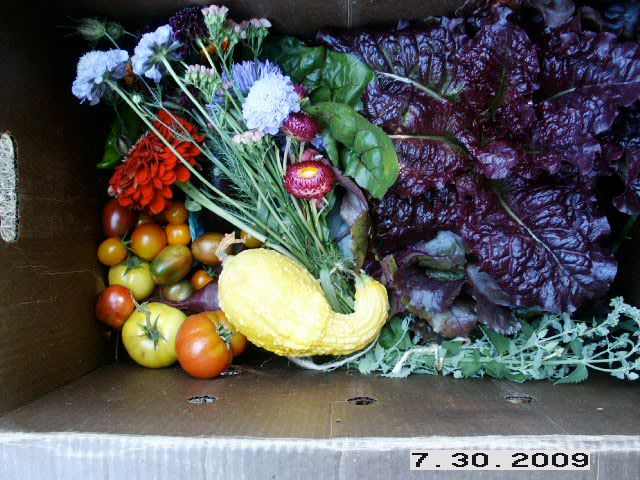
If all goes well, in the coming years, Peace of the Earth Farm will expand our CSA, start selling to local Farmers' Markets, increase our contribution to Brix 25 and possibly other local restaurants, and grow significantly more of the food our own family will consume. However, diversity is not enough if we do it alone. A strong community is very important to us and we hope our farm can help build relations ships right here in Gig Harbor and Rosedale. In the coming years we hope to have farm tours and workshops to help educate others who desire to learn more about local food as well as grow some of their own at home. Thanks again for all those who are helping to get us started! Peace!

Saturday, July 25, 2009
Keeping the wonder alive....
I just wanted to share a passage from John Steinbeck's, The Grapes of Wrath:
"And when the horse stops work and goes into the barn there is life and a vitality left, there is breathing and a warmth, and feet shift on the straw, and the jaws clamp on the hay, and the ears and eyes are alive. There is a warmth of life in the barn, and the heat and smell of life. But when the motor of a tractor stops, it is as dead as the ore it came from. The heat goes out of it like the living heat that leaves a corpse. The corrugated iron doors are closed and the tractor man drives home to town, perhaps 20 miles away, and he need not come back for weeks or months, for the tractor is dead. And this is easy and efficient. So easy that the wonder goes out of the work, so efficient that the wonder goes out of the land and the working of it, and with the wonder the deep understanding and the relation".
We understand that our small little farm is not so efficient, and not so easy, but it is filled with wonder...a wonder we feel privileged to experience and share with our community. Thanks for being part of this with us, let's keep the wonder of the food, of the land, of the living breathing life that interacts with it, alive.
peace,
Hillary
"And when the horse stops work and goes into the barn there is life and a vitality left, there is breathing and a warmth, and feet shift on the straw, and the jaws clamp on the hay, and the ears and eyes are alive. There is a warmth of life in the barn, and the heat and smell of life. But when the motor of a tractor stops, it is as dead as the ore it came from. The heat goes out of it like the living heat that leaves a corpse. The corrugated iron doors are closed and the tractor man drives home to town, perhaps 20 miles away, and he need not come back for weeks or months, for the tractor is dead. And this is easy and efficient. So easy that the wonder goes out of the work, so efficient that the wonder goes out of the land and the working of it, and with the wonder the deep understanding and the relation".
We understand that our small little farm is not so efficient, and not so easy, but it is filled with wonder...a wonder we feel privileged to experience and share with our community. Thanks for being part of this with us, let's keep the wonder of the food, of the land, of the living breathing life that interacts with it, alive.
peace,
Hillary
Labels:
farming,
horse drafting,
Organic,
steinbeck,
the grapes of wrath
Sunday, July 19, 2009
An Incredible Organization
Hello Peace of the Earth family! Hillary and I met a neighbor of ours a few weeks back and he shared with us some amazing things he is doing in Central America. Michael has created a blog about his efforts and the struggles of the Guatemalan people. You can find the blog at:
http://therippleeffectinc.blogspot.com/
Support Michael and his incredible organization.
Brian
http://therippleeffectinc.blogspot.com/
Support Michael and his incredible organization.
Brian
Thursday, July 9, 2009
First CSA Boxes Successfully Delivered!
Wednesday, July 8, 2009
A quick correction:
Hi all, I just realized that I called the "guard" leaf on my tomato trellising blog the "ground". Guard I believe is the correct term and not ground. I got in the habit once of calling it the ground and you know how habits are. Also, figure two is pretty much how the plant should look when you're done pruning... the light grayish leaves in the figure represent what will be cut. In reality you'll most likely cut A LOT more leaves then that. I simplified it for the figure so it would be more clear.
Sunday, July 5, 2009
Tomato Trellising and Pruning
It seems like everyone has their own way of pruning and trellising tomatoes and of course everyone claims to have the best method. Well, I don't want to claim that this is is the best method but it is what I have been taught and It seems to work pretty well. This is the method that Steve Solomon, author of many gardening books, most notably Gardening West of the Cascades, uses as well as The Evergreen State College Organic Farm where I studied sustainable agriculture.
When pruning a plant you may have to give yourself a pep talk before you begin. You might be worried you'll cut too much or cut the wrong thing. Tomatoes are pretty good at recovering if you cut too much or cut in the wrong place and secondly, most people actually cut too little when pruning. You may find it difficult to bring to yourself to cut large portions of the plant but try and remember that this will help the plant thrive. We prune because it helps focus the plant so it can get to the business of making the fruit as big and delicious as possible. If we don't prune, the plant will keep setting out as much leafy growth and fruit as possible....you'll get more growth and more fruit, but the flavor and size of the tomatoes will not be as desirable. Furthermore, your plant will be more susceptible to disease if your don't prune because of overcrowding of the leaves. Pruning gets the leaves and fruit up off the soil, and promotes better air circulation, both of which can help against disease.
Begin by first understanding the tomato plant's anatomy. In it's most basic state you have three main parts: the stem, the ground and the leader. The ground comes out of the main stem and the leader is right above the ground (figure 1).
Figure 1 (remember to clock on the photo for the full image)
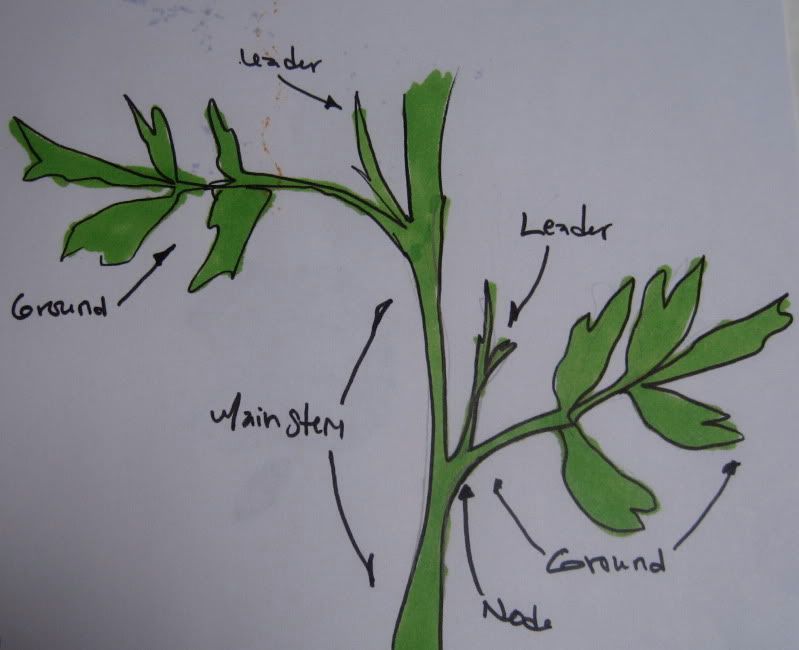
Once you understand the anatomy it is now time to do some cutting. I like to start by cleaning house. The first thing I do is cut all the suckers that start to sprout at the base of the plant. Next cut the grounds and leaders toward the bottom of the plant. You don't want a single leave touching the soil. You may need to cut off leaves as far up as 12 inches up the stem. When pruning with this method it is recommended to prune the plant down to two leaders. While you are doing these initial cuttings start trying to determine where the primary leader is, and which leader you will choose for the secondary leader (figure 2). I usually choose a leader that is fairly hardy, one that already has fruit or flowers forming, and one that is about 12 to 18 inches from the soil. I like to mentally choose a few potential candidates for the secondary leader and hold off on cutting those until I know for sure which one I'll leave. Most of the leaders will be fairly small and can easily be pinched off with your fingers, others might need a snip from some siccors.
Figure 2 (remember to click on the photo for the full image)

Of course it's usually never as perfect as figure 2 but you might be surprised at how similar your plant may look to figure 2 after you're done cutting back all the leaders.
Now it's is time to trellis the tomato plant. We use a string method. Most people try to prop the plant up using stakes or cages in an effort to combat the plants desire to follow the laws of gravity. In my opinion this is a fool hardy goal as gravity will always win and you will create a lot more work for yourself as the tomatoes get bigger and heavier. Many people are very attached to their stakes and cages and refuse to give them up, however, I implore you to try out the string method because most people find it requires a lot less maitence as the season goes on.
First drive large posts (at least 6 feet) into the ground at both end of your tomato row. Then string either wire or hardy bailing twine from one post to the other (see photo below). Then hang two pieces of bailing twine down for each tomato plant. Tie both strings to the bottom of the plant and then gently guide the plant around the strings. When you get the point when your primary leader goes one way and your secondary leader goes the other, guide one string with the primary leader and one string to the secondary leader (figure 2). Make sure the strings are fairly taught so the plant is held up. This method uses gravity to it's advantage because the plants just hang there comfortable. The tomato plant might need a little help around the twine as it grows larger, but this maintenance is fairly easy and only takes a few seconds on each plant. While you do this maintenance you should also take a few seconds to pinch off any leaders that may have started to grow since you pruned.
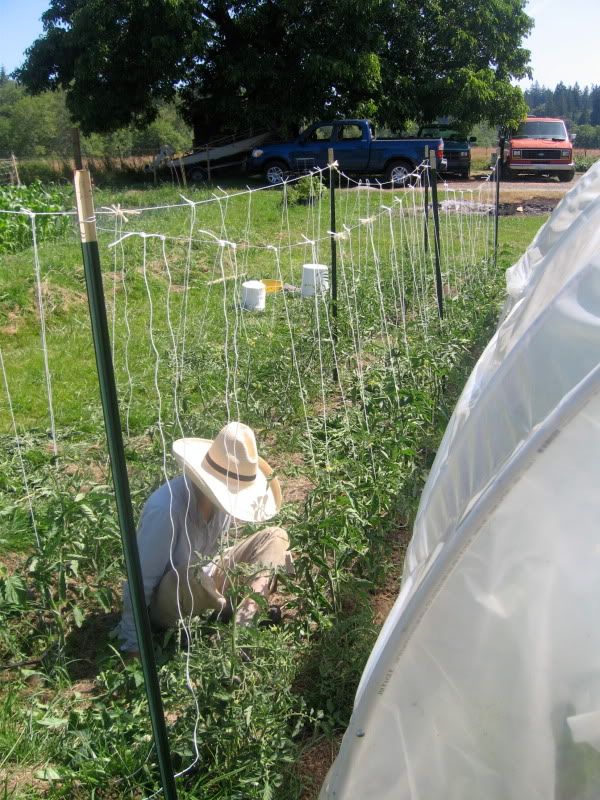
One more note about pruning: Sometimes people will leave more than two leaders early in the fruiting season. This is because you can let these additional leaders fruit once before you prune them off. It just depends on how much maintenance you want to put into the plant and how much fruit you need to get off of it. Good luck and happy trellising and pruning!
When pruning a plant you may have to give yourself a pep talk before you begin. You might be worried you'll cut too much or cut the wrong thing. Tomatoes are pretty good at recovering if you cut too much or cut in the wrong place and secondly, most people actually cut too little when pruning. You may find it difficult to bring to yourself to cut large portions of the plant but try and remember that this will help the plant thrive. We prune because it helps focus the plant so it can get to the business of making the fruit as big and delicious as possible. If we don't prune, the plant will keep setting out as much leafy growth and fruit as possible....you'll get more growth and more fruit, but the flavor and size of the tomatoes will not be as desirable. Furthermore, your plant will be more susceptible to disease if your don't prune because of overcrowding of the leaves. Pruning gets the leaves and fruit up off the soil, and promotes better air circulation, both of which can help against disease.
Begin by first understanding the tomato plant's anatomy. In it's most basic state you have three main parts: the stem, the ground and the leader. The ground comes out of the main stem and the leader is right above the ground (figure 1).
Figure 1 (remember to clock on the photo for the full image)

Once you understand the anatomy it is now time to do some cutting. I like to start by cleaning house. The first thing I do is cut all the suckers that start to sprout at the base of the plant. Next cut the grounds and leaders toward the bottom of the plant. You don't want a single leave touching the soil. You may need to cut off leaves as far up as 12 inches up the stem. When pruning with this method it is recommended to prune the plant down to two leaders. While you are doing these initial cuttings start trying to determine where the primary leader is, and which leader you will choose for the secondary leader (figure 2). I usually choose a leader that is fairly hardy, one that already has fruit or flowers forming, and one that is about 12 to 18 inches from the soil. I like to mentally choose a few potential candidates for the secondary leader and hold off on cutting those until I know for sure which one I'll leave. Most of the leaders will be fairly small and can easily be pinched off with your fingers, others might need a snip from some siccors.
Figure 2 (remember to click on the photo for the full image)

Of course it's usually never as perfect as figure 2 but you might be surprised at how similar your plant may look to figure 2 after you're done cutting back all the leaders.
Now it's is time to trellis the tomato plant. We use a string method. Most people try to prop the plant up using stakes or cages in an effort to combat the plants desire to follow the laws of gravity. In my opinion this is a fool hardy goal as gravity will always win and you will create a lot more work for yourself as the tomatoes get bigger and heavier. Many people are very attached to their stakes and cages and refuse to give them up, however, I implore you to try out the string method because most people find it requires a lot less maitence as the season goes on.
First drive large posts (at least 6 feet) into the ground at both end of your tomato row. Then string either wire or hardy bailing twine from one post to the other (see photo below). Then hang two pieces of bailing twine down for each tomato plant. Tie both strings to the bottom of the plant and then gently guide the plant around the strings. When you get the point when your primary leader goes one way and your secondary leader goes the other, guide one string with the primary leader and one string to the secondary leader (figure 2). Make sure the strings are fairly taught so the plant is held up. This method uses gravity to it's advantage because the plants just hang there comfortable. The tomato plant might need a little help around the twine as it grows larger, but this maintenance is fairly easy and only takes a few seconds on each plant. While you do this maintenance you should also take a few seconds to pinch off any leaders that may have started to grow since you pruned.

One more note about pruning: Sometimes people will leave more than two leaders early in the fruiting season. This is because you can let these additional leaders fruit once before you prune them off. It just depends on how much maintenance you want to put into the plant and how much fruit you need to get off of it. Good luck and happy trellising and pruning!
Saturday, July 4, 2009
Early July Photos
Hello all! We hope you'll enjoy these recent pictures of the farm. Remember to click on the photo for the entire image :)
We are about two thirds of the way through with our tomato trellising....a bit behind schedule but we'll get there. We are hoping to have our first ripe tomatoes by next week which should make our CSA customers very happy. If tomatoes don't make into this week's box they are sure to make it into the next week's. The beans we planted two weeks are ago are doing very well and the kohlrabi bulbs are starting to form. We just thinned our first succession of carrots and the beets are now about the size of a golf ball. All of the squash plants seem to be flourishing and you can almost watch it grown right before your eyes. The flowers are all starting to bloom just in time to make our first bouquets this week for our CSA customers. Corn is about waist high!
peace!



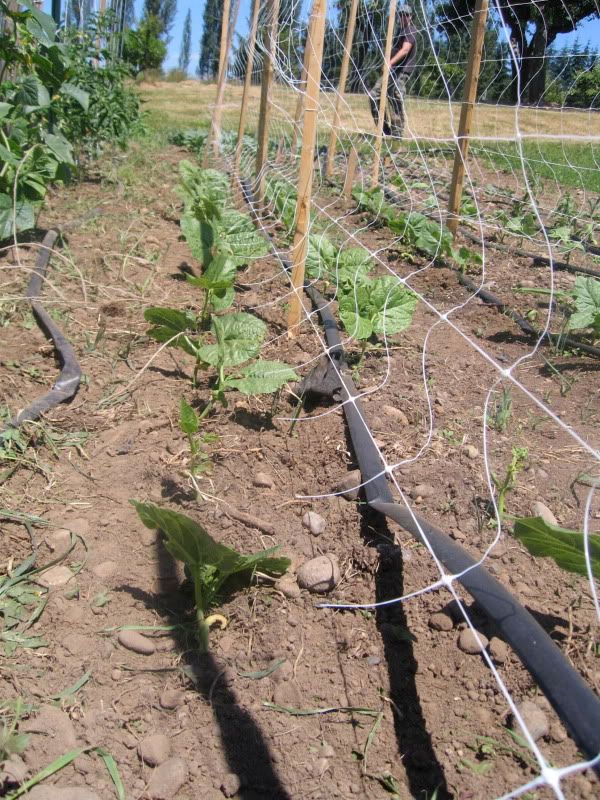
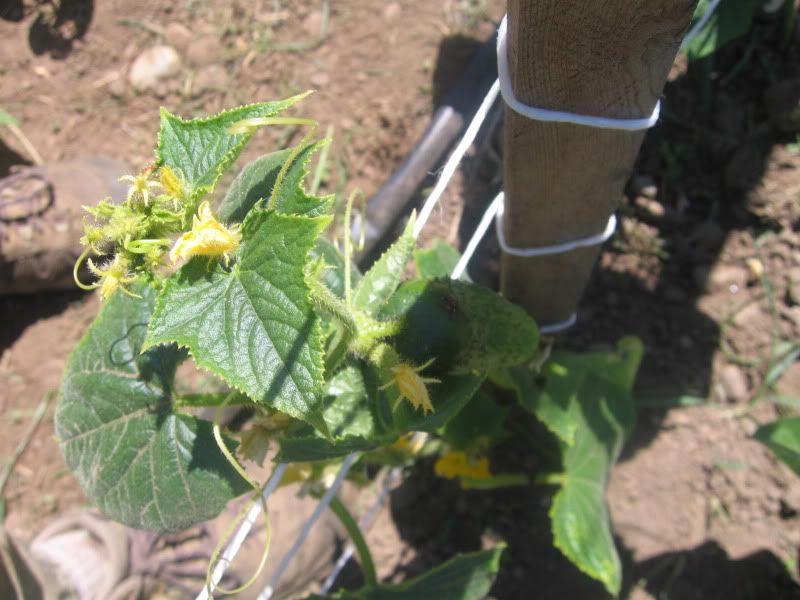





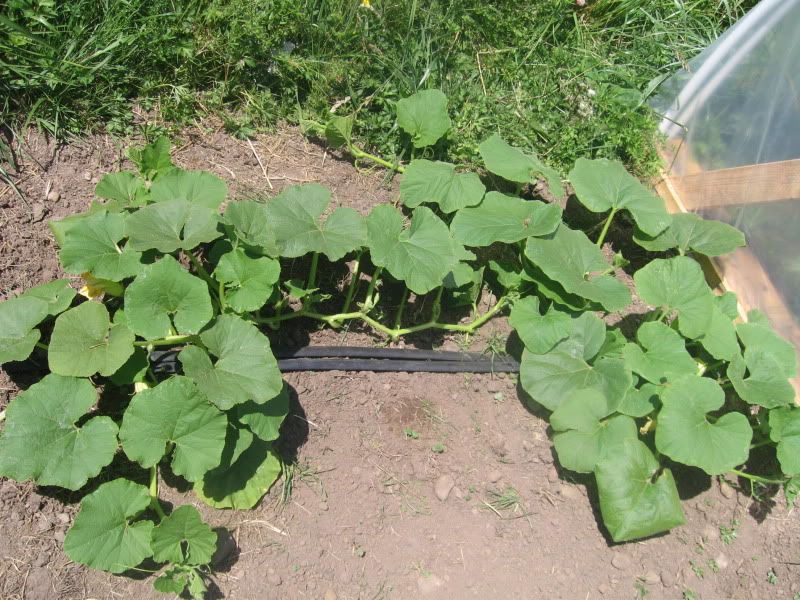
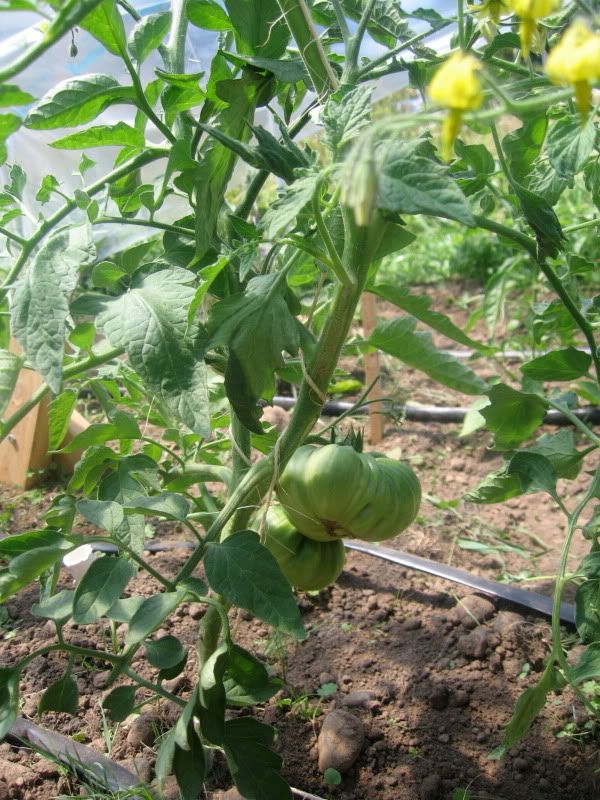
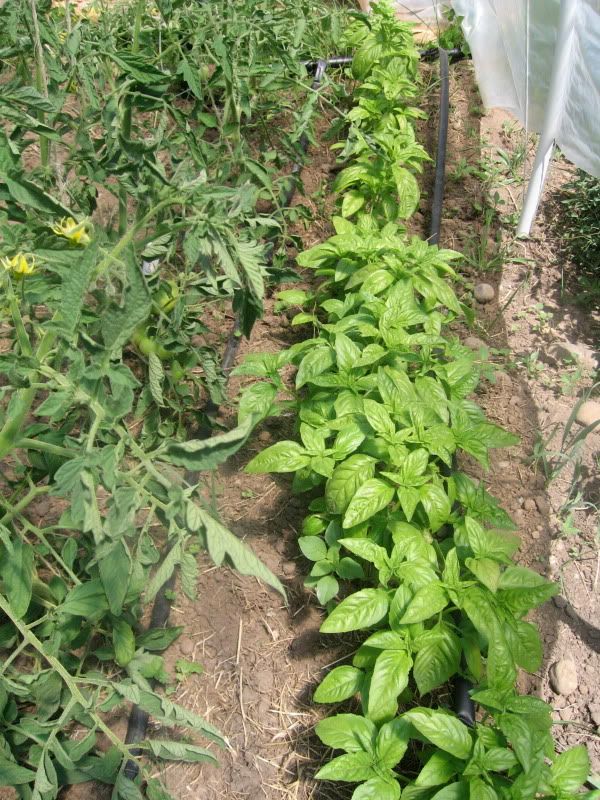
We are about two thirds of the way through with our tomato trellising....a bit behind schedule but we'll get there. We are hoping to have our first ripe tomatoes by next week which should make our CSA customers very happy. If tomatoes don't make into this week's box they are sure to make it into the next week's. The beans we planted two weeks are ago are doing very well and the kohlrabi bulbs are starting to form. We just thinned our first succession of carrots and the beets are now about the size of a golf ball. All of the squash plants seem to be flourishing and you can almost watch it grown right before your eyes. The flowers are all starting to bloom just in time to make our first bouquets this week for our CSA customers. Corn is about waist high!
peace!













Wednesday, July 1, 2009
We are starting a Community Supported Agriculture (CSA) Program!
We are looking for 2 to 4 local families or individuals to join our brand new Community Supported Agriculture Program (CSA). A CSA is a partnership between you and your farmer in which you receive a box of freshly harvested food and flowers every week for a set amount of weeks. A CSA is a wonderful way to support your local farmers as well as supply your family with the freshest and most healthy food available.
If you have been following this blog then you know that our farm values fresh food, high crop diversity, community interaction, health of the "agro-ecosystem" as well as sustainable and organic methods of farming. If you value these things as well, perhaps this CSA is for you.
Here's how it works:
Since this is our first year as an official farm we are offering our CSA at a discounted price. Most CSA programs range from about $25 to $50 a week. We are offering our CSA for $20 a week for our first year mainly because we realize that as we fine tune the process there could be a few bumps in the road. CSA programs can range from 8 to 24 weeks, or even year round. We will start our first CSA program off with a 12 week, prepaid, program ($240). Our CSA will start the week of July 13th, and run through the week of September 28th. Each week you will pick up a box of freshly harvested food and a flower bouquet right from the farm. Each box will contain enough vegetables for about 2 to 4 adults and a freshly picked bouquet of flowers. Depending on what is ready to be harvested a box might contain a mixture of lettuce, beets, carrots, kale, swiss chard, onions, kohlrabi, broccoli, corn, tomatoes, peppers, eggplant, squash, basil, and/or apples.
In the coming years we plan to become organically certified, expand the farm and include a lot more variety including more fruits, and possibly eggs, milk, cheese and meat. Believe it or not, if you choose to take part in this CSA program, you will be part of that because you are helping us build the foundation of our farm. Our most important shares will be our first shares. We want you to know that as one of our first CSA customers you are truly helping to ensure the success of your local farmers. Things might not be perfect however, and we want to make sure you understand fully what a CSA truly means. The most important aspect of a CSA is the word community; we will help each other!
Since this is our first year, we only have enough food to support 2 to 4 CSA shares so please contact us as soon as possible to ensure your spot. We also want to make sure that since we are embarking on a partnership that we are a good fit for each other. Please contact us with a few sentences about your interest in sustainable agriculture, fresh healthy foods, and your feelings about having a CSA in your community.
Please contact us via email at peaceoftheearthfarm@gmail.com if you are interested.
If you have been following this blog then you know that our farm values fresh food, high crop diversity, community interaction, health of the "agro-ecosystem" as well as sustainable and organic methods of farming. If you value these things as well, perhaps this CSA is for you.
Here's how it works:
Since this is our first year as an official farm we are offering our CSA at a discounted price. Most CSA programs range from about $25 to $50 a week. We are offering our CSA for $20 a week for our first year mainly because we realize that as we fine tune the process there could be a few bumps in the road. CSA programs can range from 8 to 24 weeks, or even year round. We will start our first CSA program off with a 12 week, prepaid, program ($240). Our CSA will start the week of July 13th, and run through the week of September 28th. Each week you will pick up a box of freshly harvested food and a flower bouquet right from the farm. Each box will contain enough vegetables for about 2 to 4 adults and a freshly picked bouquet of flowers. Depending on what is ready to be harvested a box might contain a mixture of lettuce, beets, carrots, kale, swiss chard, onions, kohlrabi, broccoli, corn, tomatoes, peppers, eggplant, squash, basil, and/or apples.
In the coming years we plan to become organically certified, expand the farm and include a lot more variety including more fruits, and possibly eggs, milk, cheese and meat. Believe it or not, if you choose to take part in this CSA program, you will be part of that because you are helping us build the foundation of our farm. Our most important shares will be our first shares. We want you to know that as one of our first CSA customers you are truly helping to ensure the success of your local farmers. Things might not be perfect however, and we want to make sure you understand fully what a CSA truly means. The most important aspect of a CSA is the word community; we will help each other!
Since this is our first year, we only have enough food to support 2 to 4 CSA shares so please contact us as soon as possible to ensure your spot. We also want to make sure that since we are embarking on a partnership that we are a good fit for each other. Please contact us with a few sentences about your interest in sustainable agriculture, fresh healthy foods, and your feelings about having a CSA in your community.
Please contact us via email at peaceoftheearthfarm@gmail.com if you are interested.
Tuesday, June 30, 2009
Farm Update
Brian and I just got back last night from a trip to visit some family in California. Leaving the farm for even a few days in the summer can be a very difficult mental struggle for any grower but we got through it. The farm looks great, baring some much needed labor in certain areas. We still need to finish trellising tomatoes and it is definitely time to do a good weeding throughout. It's amazing how much has changed in a just a few days. I think the corn grew almost a foot since last Thursday and the pole beans we planted last week with the corn have germinated and have their first true leaves. We are trying pole beans with corn because have heard from a couple sources (my grandmother, Joyce, for one), that this can be a great alternative to growing them on plain poles. The beans use the corn as a pole and in exchange furnish the corn with it's fixed nitrogen. We will give an update as to how well this worked once the beans get established. The squash too has grown quite a bit, almost doubling in size just in a few days and the flowers are starting to bloom like crazy, especially the Zinnias. The onions are growing well and we should have a harvest of at least our chipollini variety, Borretanna, in a few weeks. We'll give a photo update of all the goodness soon.
peace,
Hillary
peace,
Hillary
Monday, June 22, 2009
Island Provisions Blog is born!!
Hillary also has a business sewing vegan, handmade, wonderful goodness. Her blog can be found at islandprovisions.blogspot.com. Her storefront is found at islandprovisions1.etsy.com. Enjoy! Brian
Recent Pictures of Farm Goodness
Hi There farm lovers,
Here are a few pictures that were taken on the farm yesterday. Corn knee high by the fourth of July? Yes please. We prepared two new beds that will be filled with the next succession of beets, carrots, broccoli, kohlrabi, lettuce, a few more flowers, more squash, and herbs. Enjoy :)









Here are a few pictures that were taken on the farm yesterday. Corn knee high by the fourth of July? Yes please. We prepared two new beds that will be filled with the next succession of beets, carrots, broccoli, kohlrabi, lettuce, a few more flowers, more squash, and herbs. Enjoy :)









Sunday, June 21, 2009
A Hard Day's Work
We went out to the farm today and got some good work done. First, Hillary used our small scythe to cut down the cover crop we had sewn in the remaining unplanted area. We then "forked" the soil to break it up and get it ready for the small tiller. I spent quite a bit of time using the tiller today. The remaining grass and weeds that I was trying to till through kept getting wrapped up in the blades. It was quite a pain to keep pulling soil and grass out of the machine. We finally got through it, but not without a horrible casualty...
What I thought was an enormous weed was actually a sunflower. Hillary watched in horror across the field as I drove over the sunflower with the tiller not once, but three times. Needless to say, Hillary was not happy with me. She eventually forgave me, but the sunflower isn't going to recover.
I cut a trench and buried our main line for irrigation that ran across the field. A mower is coming through and I sure didn't want the main line to get cut into a million little pieces. The drip tape has been working out for us very well and we need to ensure that our set-up stays safe from the angry blades of the John Deere.
Finally, we laid some more drip tape in the fields for our new seeds (beans). It was a good days' work on the farm. Maddy spent her time out there playing in the mud. She eventually stripped down to her skivvies and smeared mud al over herself in homage to Lord of the Flies...such an awesome little kid.
I took a bunch of picture today and will post them tomorrow. The corn looks great and we want to share. Tomatoes all have fruit on them. Beets, carrots, onions and lettuce look incredible. I hope some of you can share in our harvest!
Brian
What I thought was an enormous weed was actually a sunflower. Hillary watched in horror across the field as I drove over the sunflower with the tiller not once, but three times. Needless to say, Hillary was not happy with me. She eventually forgave me, but the sunflower isn't going to recover.
I cut a trench and buried our main line for irrigation that ran across the field. A mower is coming through and I sure didn't want the main line to get cut into a million little pieces. The drip tape has been working out for us very well and we need to ensure that our set-up stays safe from the angry blades of the John Deere.
Finally, we laid some more drip tape in the fields for our new seeds (beans). It was a good days' work on the farm. Maddy spent her time out there playing in the mud. She eventually stripped down to her skivvies and smeared mud al over herself in homage to Lord of the Flies...such an awesome little kid.
I took a bunch of picture today and will post them tomorrow. The corn looks great and we want to share. Tomatoes all have fruit on them. Beets, carrots, onions and lettuce look incredible. I hope some of you can share in our harvest!
Brian
Saturday, June 20, 2009
Press Release - I published this tonight.
Tiny Farm has Big Dreams
You can't see it from the road. As a matter of fact, you can't see much from the road; the trees stand shoulder to shoulder providing only a glimpse of the fertile land that lies in the valley below. On the rocky, log strewn beaches of the Puget Sound only a moment before, a quick jog in the road dives into an enchanting evergreen forest speckled with modest houses and family farms just beyond the tree line. A beat-up mailbox and a gaggle of free-range chickens mark the turn to a place where seeds and dreams are being sewn.
Sun-drenched on beautiful Pacific Northwest Summer days, Peace of the Earth Farm is budding with life sustained by rich soil and cooling periodic rains. In an age where agriculture ranks far behind computers and sporting events in the average American's vast list of interests, Hillary and Brian Bergren have sought to pursue a simple and sustainable way of life. Hillary studied sustainable agriculture at The Evergreen State College under the watchful eye of some of the finest farmers in the state of Washington. The techniques and lessons she learned are now applied to the Peace of the Earth crops which include a variety of tomatoes grown in both full sun and hoop houses. Corn, onions, basil, lettuce, cut flowers, kale, artichokes, beets, carrots and swiss chard also make grand appearances. Hillary and Brian try to put as many varieties into the ground as possible to promote biodiversity and a healthy agro-ecosystem. A mature fruit orchard and a vineyard also contribute to this pursuit.
While not certified USDA Organic, Peace of the Earth Farm is 100% pesticide free and adheres to the the organic standards set forth by the agency. When the minimum time period has passed (land must be used in an organic manner for a specific number of years), the Bergren family plans to submit an application for certification. Until then, the local community will come to understand that an organic label in a sterile grocery store is not a recipe for nutrition. Local, freshly picked, sustainably grown and harvested produce is healthier on so many levels. Of note, the community is healthier when local businesses are supported and hometown dollars go back into the hometown. In these times of economic uncertainty, it is important to encourage and support those who enrich the community with unique talents, services and abilities.
One way the community of Gig Harbor, Washington can support Peace of the Earth Farm is to become shareholders in the community supported agriculture program (CSA) launching in May of 2010. The purchase of a share will result in a gorgeous box of sustainably grown produce and flowers delivered direct to the members. Knowing that the food on the table at night was picked that morning by a local couple trying to do their part to save the world will be very satisfying to those who take part in the CSA. Also, people all over the world can support the farm by visiting the “Farm Blog” at http://tubbergren.blogspot.com.
As you read about this tiny farm that will soon expand to 2 acres of pasture land, imagine a family with their hands in the dirt, smiles on their faces and so many dreams to sow before the sun goes down.
# # #
About Peace of the Earth Farm: POTE Farm is a small-scale, sustainable farm in Gig Harbor, Washington. Brian and Hillary Bergren are the stewards of the farm and hope to expand into adjacent acreage and begin a community supported agriculture program in the next few years.
You can't see it from the road. As a matter of fact, you can't see much from the road; the trees stand shoulder to shoulder providing only a glimpse of the fertile land that lies in the valley below. On the rocky, log strewn beaches of the Puget Sound only a moment before, a quick jog in the road dives into an enchanting evergreen forest speckled with modest houses and family farms just beyond the tree line. A beat-up mailbox and a gaggle of free-range chickens mark the turn to a place where seeds and dreams are being sewn.
Sun-drenched on beautiful Pacific Northwest Summer days, Peace of the Earth Farm is budding with life sustained by rich soil and cooling periodic rains. In an age where agriculture ranks far behind computers and sporting events in the average American's vast list of interests, Hillary and Brian Bergren have sought to pursue a simple and sustainable way of life. Hillary studied sustainable agriculture at The Evergreen State College under the watchful eye of some of the finest farmers in the state of Washington. The techniques and lessons she learned are now applied to the Peace of the Earth crops which include a variety of tomatoes grown in both full sun and hoop houses. Corn, onions, basil, lettuce, cut flowers, kale, artichokes, beets, carrots and swiss chard also make grand appearances. Hillary and Brian try to put as many varieties into the ground as possible to promote biodiversity and a healthy agro-ecosystem. A mature fruit orchard and a vineyard also contribute to this pursuit.
While not certified USDA Organic, Peace of the Earth Farm is 100% pesticide free and adheres to the the organic standards set forth by the agency. When the minimum time period has passed (land must be used in an organic manner for a specific number of years), the Bergren family plans to submit an application for certification. Until then, the local community will come to understand that an organic label in a sterile grocery store is not a recipe for nutrition. Local, freshly picked, sustainably grown and harvested produce is healthier on so many levels. Of note, the community is healthier when local businesses are supported and hometown dollars go back into the hometown. In these times of economic uncertainty, it is important to encourage and support those who enrich the community with unique talents, services and abilities.
One way the community of Gig Harbor, Washington can support Peace of the Earth Farm is to become shareholders in the community supported agriculture program (CSA) launching in May of 2010. The purchase of a share will result in a gorgeous box of sustainably grown produce and flowers delivered direct to the members. Knowing that the food on the table at night was picked that morning by a local couple trying to do their part to save the world will be very satisfying to those who take part in the CSA. Also, people all over the world can support the farm by visiting the “Farm Blog” at http://tubbergren.blogspot.com.
As you read about this tiny farm that will soon expand to 2 acres of pasture land, imagine a family with their hands in the dirt, smiles on their faces and so many dreams to sow before the sun goes down.
# # #
About Peace of the Earth Farm: POTE Farm is a small-scale, sustainable farm in Gig Harbor, Washington. Brian and Hillary Bergren are the stewards of the farm and hope to expand into adjacent acreage and begin a community supported agriculture program in the next few years.
Eat your Greens??
Care to have a little snack before your beets are fully developed? The beet greens are delicious this time of year. As you are thinning your beets, don't just throw the tops away...what a waste! The little beets are the perfect size for pickling and are especially tender and delicious. The tops are great in a mixed green salad or as a substitute for boring old lettuce. Eat you greens!
Going out to the farm today and taking some friends. We love sharing our farm. Holler if you are in Gig Harbor and want to check it out.
Brian
Going out to the farm today and taking some friends. We love sharing our farm. Holler if you are in Gig Harbor and want to check it out.
Brian
Thursday, June 18, 2009
Shop Small for Heirloom Seeds
Looking for great varieties of heirloom seeds...guess what? you probably won't find them in the stores....go to the source, the farmers! Just in case you don't know any farmers you can get started on Etsy.com
Check out this treasury page for a hand full of shops who sell seeds to get started:
http://www.etsy.com/treasury_list.php?room_id=65220
This page expires tonight at about 11:30 eastern time so if you're reading this after Thursday June 18th, try going to Etsy.com and searching for "heirloom seeds". You'll be buying a product that tastes better, is better for the diversity of our farms, and supports small scale farming operations and small business owners...go on now, get to it!
Check out this treasury page for a hand full of shops who sell seeds to get started:
http://www.etsy.com/treasury_list.php?room_id=65220
This page expires tonight at about 11:30 eastern time so if you're reading this after Thursday June 18th, try going to Etsy.com and searching for "heirloom seeds". You'll be buying a product that tastes better, is better for the diversity of our farms, and supports small scale farming operations and small business owners...go on now, get to it!
Wednesday, June 17, 2009
Tuesday, June 16, 2009
A little history...
Brian is an officer in the USAF and goes by the callsign "tub"; hence, the name of the blog page tubbergren.blogspot.com.
Hillary has been studying sustainable agriculture at The Evergreen State College in Olympia, WA.
We have a4 year old daughter named Madeline who goes by the nickname "Maddy"
About 6 months ago, some personal friends of ours Jon and Pat Lantz offered up their property in Rosedale, Washington. They wanted someone to use the property and knew we had an interest in agriculture.
We jumped at the chance! We are starting off small, but plan to expand to the surrounding acreage in the coming years. We are going to start a CSA and invite the community to purchase shares of the farm. For their investment, shareholders will receive boxes of produce weekly.
We can't wait to expand the farm and bring our fresh, organic produce to Gig Harbor and surrounding communities. Your visits to this site and interest in advertisers will generate dollars that will go right back into the farm. We really appreciate the support!
Please visit often and follow our progress. We want the farm to become a part of the community and your support will make that a reality.
Thanks for supporting Peace of the Earth Organic Farm...
Brian
Hillary has been studying sustainable agriculture at The Evergreen State College in Olympia, WA.
We have a4 year old daughter named Madeline who goes by the nickname "Maddy"
About 6 months ago, some personal friends of ours Jon and Pat Lantz offered up their property in Rosedale, Washington. They wanted someone to use the property and knew we had an interest in agriculture.
We jumped at the chance! We are starting off small, but plan to expand to the surrounding acreage in the coming years. We are going to start a CSA and invite the community to purchase shares of the farm. For their investment, shareholders will receive boxes of produce weekly.
We can't wait to expand the farm and bring our fresh, organic produce to Gig Harbor and surrounding communities. Your visits to this site and interest in advertisers will generate dollars that will go right back into the farm. We really appreciate the support!
Please visit often and follow our progress. We want the farm to become a part of the community and your support will make that a reality.
Thanks for supporting Peace of the Earth Organic Farm...
Brian
Labels:
Farm,
History,
Organic,
Sustainable
Press Release
I just submitted a press release to try to generate more traffic for this blog. The release can be found at:
http://www.free-press-release.com/news/200906/1245209908.html' target='_blank'>Press Release: Small-scale, Sustainable Farm Blog Launches
Read and Enjoy!
Brian
http://www.free-press-release.com/news/200906/1245209908.html' target='_blank'>Press Release: Small-scale, Sustainable Farm Blog Launches
Read and Enjoy!
Brian
Monday, June 15, 2009
Farm update
Today was a typical day on the farm and I thought it would be good to share with you what I did.
First, I took a farm walk. Going on a farm walk at the start and finish of each day is extremely important, no matter how small or large the farm is. This daily contact with each facet of the farm helps me stay connected to the crops and what is going on around them. As I walk, I look at the general health of the plants, take note of any weeding that needs to be done, put my hand a few inches in the soil to check moisture and also I take a very close inspection of at least one plant of each variety and crop. This last step is very important, especially for organic and natural farmers. I need to know exactly what is going on with the plants. If there is insect or other animal damage, the type of damage can tell me a lot. For instance, tiny, very uniform holes that resemble "BB gun" holes are probably flea beetles. I might also see the actual insect pest, such as aphids. If I know early enough what the insect problem is, I can more easily come up with a prevention solution. Remember that with organic and natural farming, prevention is key. Also, when I find a "pest", I should not just assume that there is an outbreak. If I look closer, I might also see the pest's predator, such as lace wings or lady bug larvae. All farmers and gardeners should have at least a basic understanding of common pests and their predators. A good book on the subject: "Biodiversity and Pest Management in Agroecosystems" by Miguel Altieri. On my farm walks I also like to do some observation of the local wildlife....the pollinators, the ground life, the birds, the non-cultivated plants, etc, etc, etc... this is all part of the farm habitat, or as Miguel Altieri calls it, the agroecosystem, and I want to help keep it healthy. Today everything looked great; no major issues to report.
I then started pruning and trellising some tomatoes. We use the string method for trellising and I'll post a blog soon with pictures and step by step instructions on how to trellis with this method and show how we prune (it seems everyone does this differently, but I'll share what I have learned).
Next, I did some transplanting. I transplanted two month old peppers (cayenne- "long thin ring of fire", bells-"gold Marconi", and a Habenero variety), egg plants ("oriental express"), more basil ("aroma"), kholrabi ("korridor"), arugula ("astro"), some herbs (including skullcap, vervain, and sage), and flowers ("bells of ireland", echinacea, and delphinium). I made sure to water in all the new plants.
Lastly I weeded around some borage, nigella ("love in a mist" best name ever for a flower), sage, butterfly weed, and echinacea.
First, I took a farm walk. Going on a farm walk at the start and finish of each day is extremely important, no matter how small or large the farm is. This daily contact with each facet of the farm helps me stay connected to the crops and what is going on around them. As I walk, I look at the general health of the plants, take note of any weeding that needs to be done, put my hand a few inches in the soil to check moisture and also I take a very close inspection of at least one plant of each variety and crop. This last step is very important, especially for organic and natural farmers. I need to know exactly what is going on with the plants. If there is insect or other animal damage, the type of damage can tell me a lot. For instance, tiny, very uniform holes that resemble "BB gun" holes are probably flea beetles. I might also see the actual insect pest, such as aphids. If I know early enough what the insect problem is, I can more easily come up with a prevention solution. Remember that with organic and natural farming, prevention is key. Also, when I find a "pest", I should not just assume that there is an outbreak. If I look closer, I might also see the pest's predator, such as lace wings or lady bug larvae. All farmers and gardeners should have at least a basic understanding of common pests and their predators. A good book on the subject: "Biodiversity and Pest Management in Agroecosystems" by Miguel Altieri. On my farm walks I also like to do some observation of the local wildlife....the pollinators, the ground life, the birds, the non-cultivated plants, etc, etc, etc... this is all part of the farm habitat, or as Miguel Altieri calls it, the agroecosystem, and I want to help keep it healthy. Today everything looked great; no major issues to report.
I then started pruning and trellising some tomatoes. We use the string method for trellising and I'll post a blog soon with pictures and step by step instructions on how to trellis with this method and show how we prune (it seems everyone does this differently, but I'll share what I have learned).
Next, I did some transplanting. I transplanted two month old peppers (cayenne- "long thin ring of fire", bells-"gold Marconi", and a Habenero variety), egg plants ("oriental express"), more basil ("aroma"), kholrabi ("korridor"), arugula ("astro"), some herbs (including skullcap, vervain, and sage), and flowers ("bells of ireland", echinacea, and delphinium). I made sure to water in all the new plants.
Lastly I weeded around some borage, nigella ("love in a mist" best name ever for a flower), sage, butterfly weed, and echinacea.
Tips about Basil
Hillary taught me a few things about Basil yesterday and I want to share them.
First of all, basil and tomatoes compliment each other quite nicely. Plant basil along the base of your tomatoes (about a foot away) and you have just tried "companion planting". Some people find this to be more fiction than fact, but a lot of people have success.
You need to prune the basil early in the growing process. Pull off the sad leaves around the base. Also, pinch off at least the top two leaves. This will promote growth of new leaves and help the plant grow more "bushy". If you don't do this, the plant will only get taller, but will not have new growth. Then, it will go to seed much too early. If it looks like the plant is healthy, take off the next set of leaves as well. If it is a sickly little bugger, it is best just to pinch off the very top. In a few weeks, after the shoots on the side have grown, you should pinch the tops off the side shoots.
We made a pesto pizza last night with the basil from the farm. Delicious.
First of all, basil and tomatoes compliment each other quite nicely. Plant basil along the base of your tomatoes (about a foot away) and you have just tried "companion planting". Some people find this to be more fiction than fact, but a lot of people have success.
You need to prune the basil early in the growing process. Pull off the sad leaves around the base. Also, pinch off at least the top two leaves. This will promote growth of new leaves and help the plant grow more "bushy". If you don't do this, the plant will only get taller, but will not have new growth. Then, it will go to seed much too early. If it looks like the plant is healthy, take off the next set of leaves as well. If it is a sickly little bugger, it is best just to pinch off the very top. In a few weeks, after the shoots on the side have grown, you should pinch the tops off the side shoots.
We made a pesto pizza last night with the basil from the farm. Delicious.
Sunday, June 14, 2009
A bunch of pictures from our day on the farm -- First Harvest!!
The following pictures were all taken today. As you can see, the farm is coming along. However, we did find that a few of our tomatoes had been nibbled on by a sneaky raccoon or a devious deer. All part of being farmers, I suppose. We plan to put a deer fence up soon; we will acquire some old fish nets from our local fishermen and string them between tall posts. Hopefully, that will at least keep the deer out. Not much we can do about raccoons. Anyone have any ideas?
These pictures show the various crops we are growing. Also, the hoop house can be seen. We will provide a more detailed description of how we fashioned the hoop house in a future blog. We finally harvested some lettuce today and shared the heads with our friends in the neighborhood. We made a delicious salad with our head. The leaves were so crisp and fresh...nothing like fresh lettuce just pulled from the ground. Please enjoy the photos and let us know if you have any questions or want to share some comments.
Some of the images have been cropped. If you want to see the whole image, just click on it! Another window will open in Photobucket.
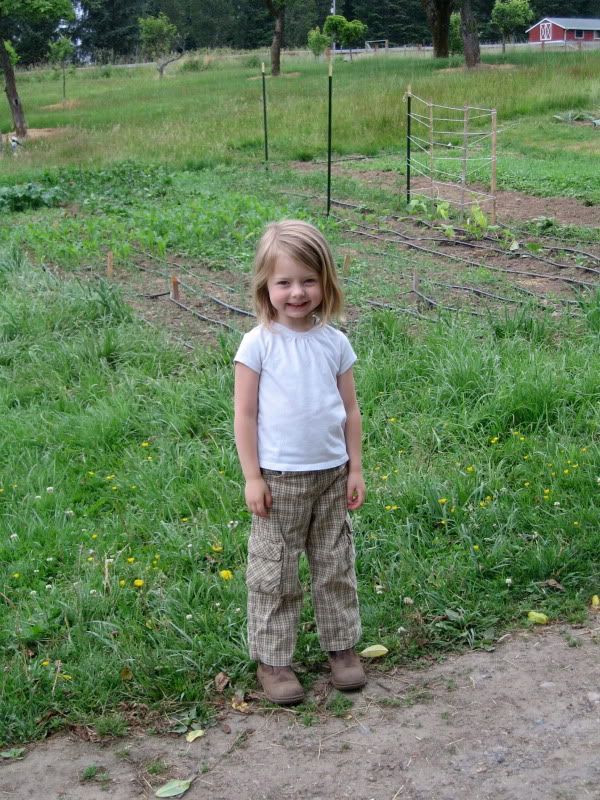


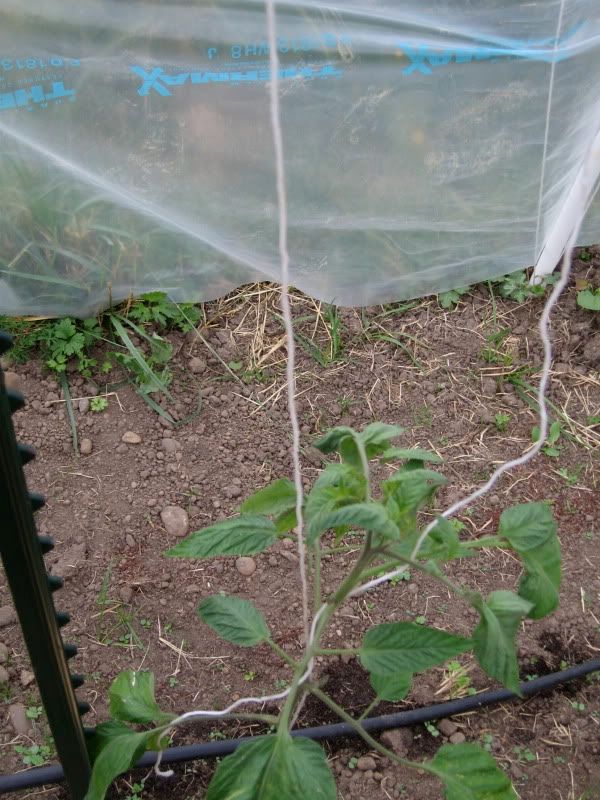
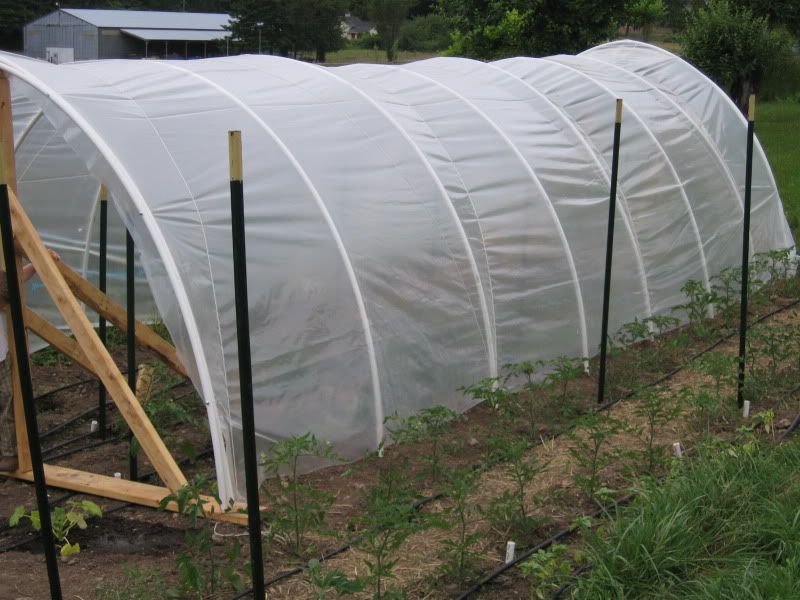



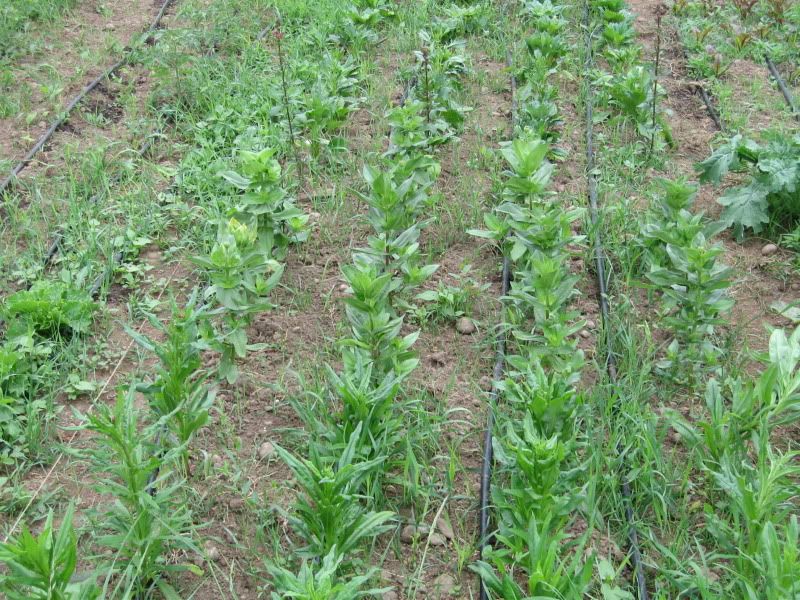










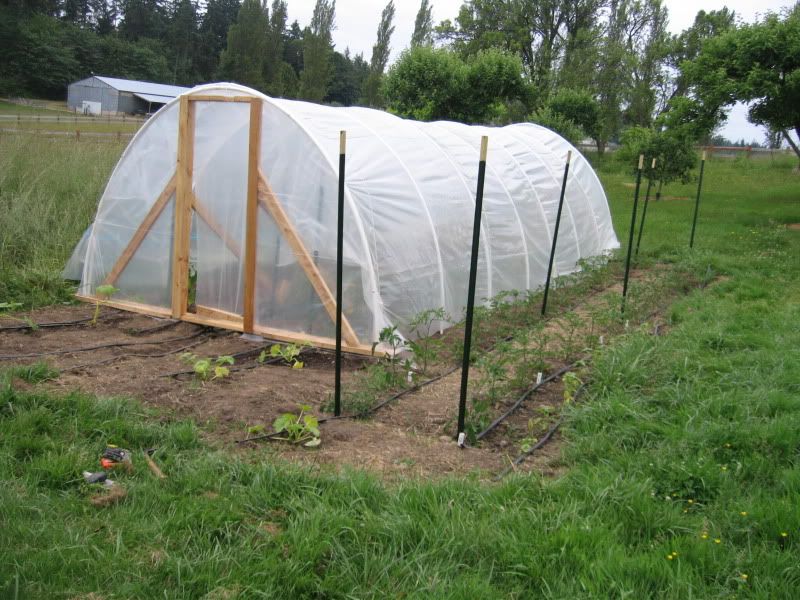
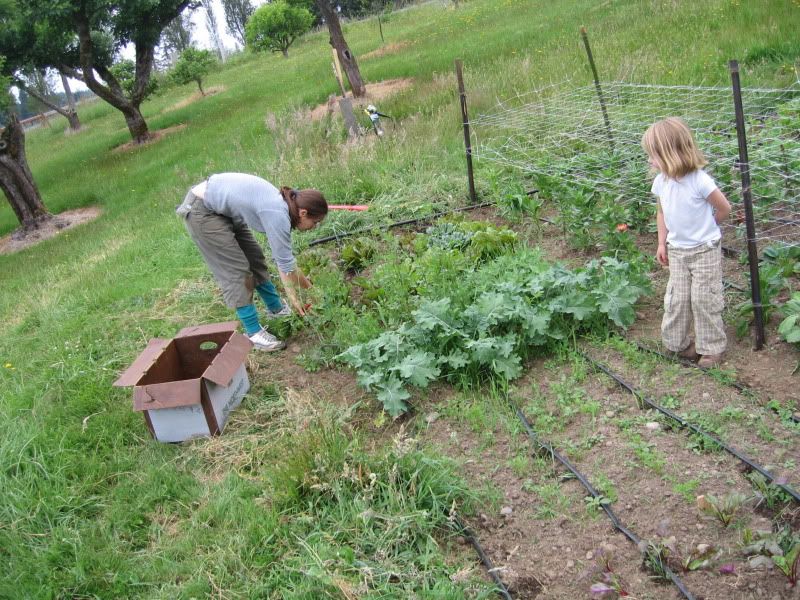


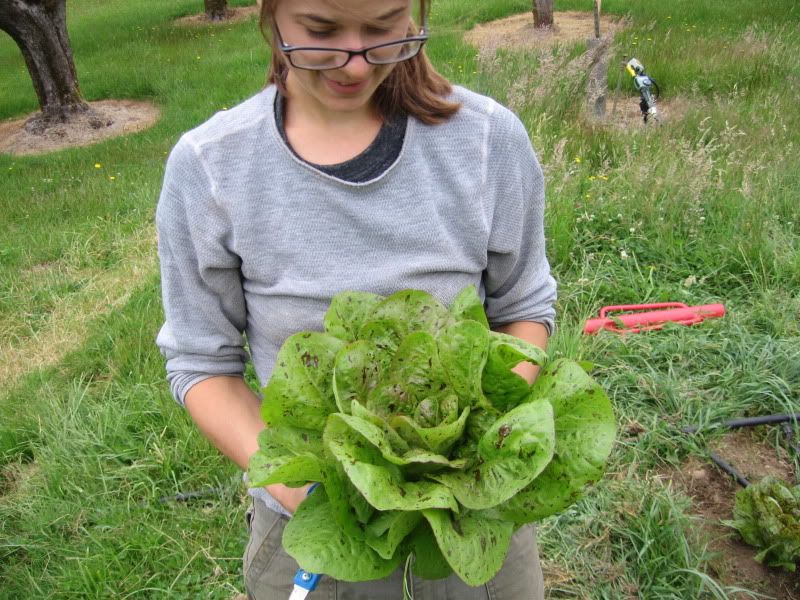
Some of the images have been cropped. If you want to see the whole image, just click on it! Another window will open in Photobucket.
























Subscribe to:
Posts (Atom)
